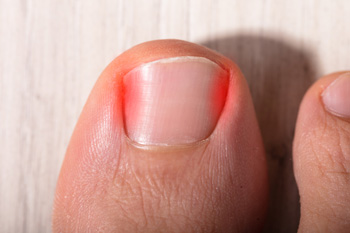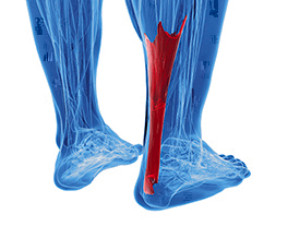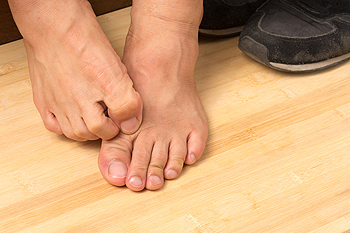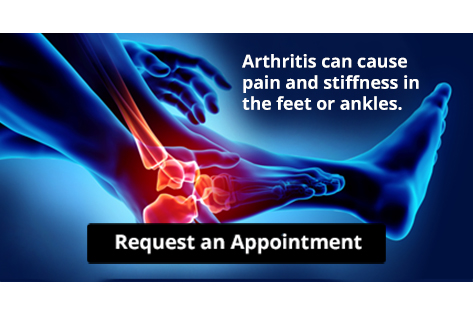July 2020
Medical Treatment May Be Needed for Ingrown Toenails
 An ingrown toenail is a common condition in which the corner of a nail grows into the surrounding skin, leading to inflammation, pain, and sometimes even infection. While home remedies and preventative care may be adequate for treating milder cases of ingrown toenails, sometimes medical intervention is necessary, especially for moderate to severe cases. Seeing a podiatrist may benefit people who are prone to recurrent ingrown nails. There are a variety of medical treatments for ingrown nails, such as lifting or partially removing the nail. A recent study has found that patients who receive medical treatment for ingrown nails are generally satisfied with the outcome and may experience an improvement in their overall quality of life. If you find yourself afflicted with painful or frequent ingrown toenails, it is recommended that you visit a podiatrist.
An ingrown toenail is a common condition in which the corner of a nail grows into the surrounding skin, leading to inflammation, pain, and sometimes even infection. While home remedies and preventative care may be adequate for treating milder cases of ingrown toenails, sometimes medical intervention is necessary, especially for moderate to severe cases. Seeing a podiatrist may benefit people who are prone to recurrent ingrown nails. There are a variety of medical treatments for ingrown nails, such as lifting or partially removing the nail. A recent study has found that patients who receive medical treatment for ingrown nails are generally satisfied with the outcome and may experience an improvement in their overall quality of life. If you find yourself afflicted with painful or frequent ingrown toenails, it is recommended that you visit a podiatrist.
Ingrown toenails can become painful if they are not treated properly. For more information about ingrown toenails, contact Dr. Lee R. Stein of Lake Shore Foot & Ankle, PC. Our doctor can provide the care you need to keep you pain-free and on your feet.
Ingrown Toenails
Ingrown toenails occur when a toenail grows sideways into the bed of the nail, causing pain, swelling, and possibly infection.
Causes
- Bacterial infections
- Improper nail cutting such as cutting it too short or not straight across
- Trauma to the toe, such as stubbing, which causes the nail to grow back irregularly
- Ill-fitting shoes that bunch the toes too close together
- Genetic predisposition
Prevention
Because ingrown toenails are not something found outside of shoe-wearing cultures, going barefoot as often as possible will decrease the likeliness of developing ingrown toenails. Wearing proper fitting shoes and using proper cutting techniques will also help decrease your risk of developing ingrown toenails.
Treatment
Ingrown toenails are a very treatable foot condition. In minor cases, soaking the affected area in salt or antibacterial soaps will not only help with the ingrown nail itself, but also help prevent any infections from occurring. In more severe cases, surgery is an option. In either case, speaking to your podiatrist about this condition will help you get a better understanding of specific treatment options that are right for you.
If you have any questions please feel free to contact one of our offices located in Chicago, Highland Park, and Uptown, IL . We offer the newest diagnostic and treatment technologies for all your foot and ankle needs.
How Obesity Can Hurt Your Feet
 Obesity can cause a variety of health problems throughout the entire body. One often overlooked area that is affected by obesity are the feet. Studies have found that general foot pain and plantar heel pain are strongly associated with an increase in body mass index. That is, the higher your weight, the more likely you are to develop pain in your feet. Furthermore, obese individuals are more likely to have flat feet, which can result in strained muscles and ligaments that bring about foot pain. Obese individuals are also at greater risk of developing poor circulation to the feet, peripheral artery disease, and peripheral neuropathy, all of which lead to decreased foot function. A podiatrist can help address concerns regarding your foot health, and provide advice regarding what you can do to improve it.
Obesity can cause a variety of health problems throughout the entire body. One often overlooked area that is affected by obesity are the feet. Studies have found that general foot pain and plantar heel pain are strongly associated with an increase in body mass index. That is, the higher your weight, the more likely you are to develop pain in your feet. Furthermore, obese individuals are more likely to have flat feet, which can result in strained muscles and ligaments that bring about foot pain. Obese individuals are also at greater risk of developing poor circulation to the feet, peripheral artery disease, and peripheral neuropathy, all of which lead to decreased foot function. A podiatrist can help address concerns regarding your foot health, and provide advice regarding what you can do to improve it.
Obesity has become very problematic at this point in time and can have extremely negative effects on the feet. If you’re an obese individual and are concerned about your feet, contact Dr. Lee R. Stein from Lake Shore Foot & Ankle, PC. Our doctor can provide the care you need to keep you pain-free and on your feet.
Obesity and Your Feet
Since your feet are what support your entire weight when standing, any additional weight can result in pain and swelling. Being overweight is one of the main contributors to foot complications.
Problems & Complications
Extra Weight – Even putting on just a few extra pounds could create serious complications for your feet. As your weight increases, your balance and body will shift, creating new stresses on your feet. This uneven weight distribution can cause pain, even while doing the simplest tasks, such as walking.
Diabetes – People who are overweight are at serious risk of developing type-2 diabetes, which has a drastic impact on the health of your feet. As you get older, your diabetes might worsen, which could lead to loss of feeling in your feet, sores, and bruises. You could also become more prone to various infections.
Plantar fasciitis – Pressure and stress that is placed on muscles, joints, and tendons can trigger plantar fasciitis, which is an inflammation of tissue that forms along the bottom of the foot.
If you have any questions please feel free to contact one of our offices located in Chicago, Highland Park, and Uptown, IL . We offer the newest diagnostic and treatment technologies for all your foot and ankle needs.
Arthritis Can Cause Pain in the Feet and Ankles
Achilles Tendon Ruptures
 An Achilles tendon rupture occurs when the tendon on the back of the ankle is torn. Achilles tendon ruptures primarily occur during activities that involve pushing off of the ground or sprinting, like tennis and basketball. Some of the risk factors can include old age, poor flexibility, an inactive lifestyle, and steroid medications. Generally, most ruptures are not tied to a specific injury and are not indicated by pain before the rupture happens. A rupture is usually indicated by sudden pain that is said to be like getting kicked in the back of the leg, and a feeling or hearing of a pop in the tendon. If you have experienced an Achilles tendon rupture, be sure to consult with a podiatrist immediately. Surgery may be necessary, but it can be avoided with proper casting and physical therapy. Either way, it may take up to 6 months for a full recovery so it is imperative that you consult with a podiatrist.
An Achilles tendon rupture occurs when the tendon on the back of the ankle is torn. Achilles tendon ruptures primarily occur during activities that involve pushing off of the ground or sprinting, like tennis and basketball. Some of the risk factors can include old age, poor flexibility, an inactive lifestyle, and steroid medications. Generally, most ruptures are not tied to a specific injury and are not indicated by pain before the rupture happens. A rupture is usually indicated by sudden pain that is said to be like getting kicked in the back of the leg, and a feeling or hearing of a pop in the tendon. If you have experienced an Achilles tendon rupture, be sure to consult with a podiatrist immediately. Surgery may be necessary, but it can be avoided with proper casting and physical therapy. Either way, it may take up to 6 months for a full recovery so it is imperative that you consult with a podiatrist.
Achilles tendon injuries need immediate attention to avoid future complications. If you have any concerns, contact Dr. Lee R. Stein of Lake Shore Foot & Ankle, PC. Our doctor can provide the care you need to keep you pain-free and on your feet.
What Is the Achilles Tendon?
The Achilles tendon is a tendon that connects the lower leg muscles and calf to the heel of the foot. It is the strongest tendon in the human body and is essential for making movement possible. Because this tendon is such an integral part of the body, any injuries to it can create immense difficulties and should immediately be presented to a doctor.
What Are the Symptoms of an Achilles Tendon Injury?
There are various types of injuries that can affect the Achilles tendon. The two most common injuries are Achilles tendinitis and ruptures of the tendon.
Achilles Tendinitis Symptoms
- Inflammation
- Dull to severe pain
- Increased blood flow to the tendon
- Thickening of the tendon
Rupture Symptoms
- Extreme pain and swelling in the foot
- Total immobility
Treatment and Prevention
Achilles tendon injuries are diagnosed by a thorough physical evaluation, which can include an MRI. Treatment involves rest, physical therapy, and in some cases, surgery. However, various preventative measures can be taken to avoid these injuries, such as:
- Thorough stretching of the tendon before and after exercise
- Strengthening exercises like calf raises, squats, leg curls, leg extensions, leg raises, lunges, and leg presses
If you have any questions please feel free to contact one of our offices located in Chicago, Highland Park, and Uptown, IL . We offer the newest diagnostic tools and technology to treat your foot and ankle needs.
Common Symptoms of Athlete’s Foot
 There are common symptoms that are associated with the condition that is known as athlete’s foot. These can consist of an itchy and burning sensation between the toes or on the bottom of the feet, and the skin may become flaky. It is caused by a fungus that lives and thrives in warm and moist environments, including public swimming pools, communal shower room floors, and surrounding areas. If left untreated, it can cause severe pain and discomfort. For mild cases, it may be beneficial to apply an antifungal cream or powder on the affected area. If you are suffering from this ailment, it is strongly advised that you speak to a podiatrist who can successfully diagnose and treat athlete's foot.
There are common symptoms that are associated with the condition that is known as athlete’s foot. These can consist of an itchy and burning sensation between the toes or on the bottom of the feet, and the skin may become flaky. It is caused by a fungus that lives and thrives in warm and moist environments, including public swimming pools, communal shower room floors, and surrounding areas. If left untreated, it can cause severe pain and discomfort. For mild cases, it may be beneficial to apply an antifungal cream or powder on the affected area. If you are suffering from this ailment, it is strongly advised that you speak to a podiatrist who can successfully diagnose and treat athlete's foot.
Athlete’s foot is an inconvenient condition that can be easily reduced with the proper treatment. If you have any concerns about your feet and ankles, contact Dr. Lee R. Stein from Lake Shore Foot & Ankle, PC. Our doctor will treat your foot and ankle needs.
Athlete’s Foot: The Sole Story
Athlete's foot, also known as tinea pedis, can be an extremely contagious foot infection. It is commonly contracted in public changing areas and bathrooms, dormitory style living quarters, around locker rooms and public swimming pools, or anywhere your feet often come into contact with other people.
Solutions to Combat Athlete’s Foot
- Hydrate your feet by using lotion
- Exfoliate
- Buff off nails
- Use of anti-fungal products
- Examine your feet and visit your doctor if any suspicious blisters or cuts develop
Athlete’s foot can cause many irritating symptoms such as dry and flaking skin, itching, and redness. Some more severe symptoms can include bleeding and cracked skin, intense itching and burning, and even pain when walking. In the worst cases, Athlete’s foot can cause blistering as well. Speak to your podiatrist for a better understanding of the different causes of Athlete’s foot, as well as help in determining which treatment options are best for you.
If you have any questions please feel free to contact one of our offices located in Chicago, Highland Park, and Uptown, IL . We offer the newest diagnostic and treatment technologies for all your foot and ankle needs.
Blog Archives
- April 2025
- March 2025
- February 2025
- January 2025
- December 2024
- November 2024
- October 2024
- September 2024
- August 2024
- July 2024
- June 2024
- May 2024
- April 2024
- March 2024
- February 2024
- January 2024
- December 2023
- November 2023
- October 2023
- September 2023
- August 2023
- July 2023
- June 2023
- May 2023
- April 2023
- March 2023
- February 2023
- January 2023
- December 2022
- November 2022
- October 2022
- September 2022
- August 2022
- July 2022
- June 2022
- May 2022
- April 2022
- March 2022
- February 2022
- January 2022
- December 2021
- November 2021
- October 2021
- September 2021
- August 2021
- July 2021
- June 2021
- May 2021
- April 2021
- March 2021
- February 2021
- January 2021
- December 2020
- November 2020
- October 2020
- September 2020
- August 2020
- July 2020
- June 2020
- May 2020
- April 2020
- March 2020
- February 2020
- January 2020
- December 2019
- November 2019
- October 2019
- September 2019
- August 2019
- July 2019
- June 2019
- May 2019
- April 2019
- March 2019
- February 2019
- January 2019
- December 2018
- November 2018
- October 2018
- September 2018
- August 2018
- July 2018








